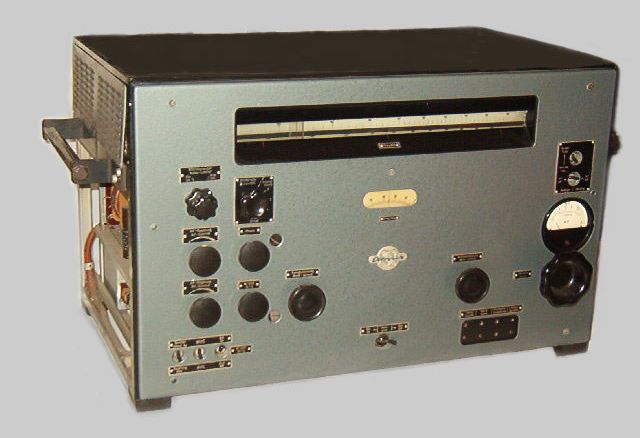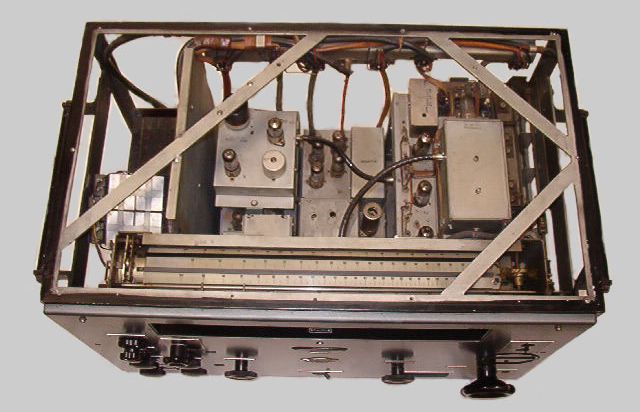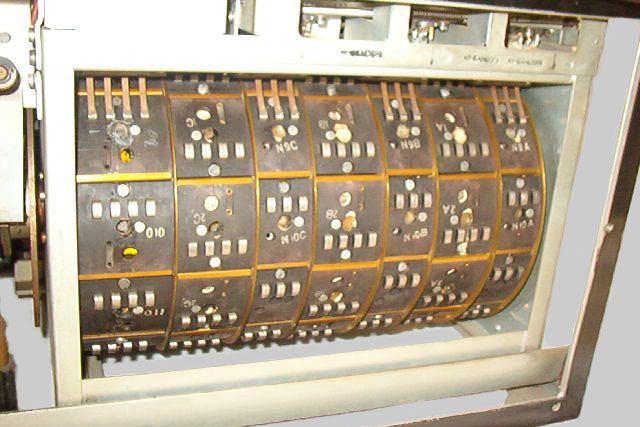
|
|
 |
| Shortwave Communications Receiver |
| Double Conversion Superheterodyne |
| 21 Tubes + Semiconductors |
| Made in West Germany 1952 - 1955? |
| Specifications | |
| Coverage: | 1.6
– 2.1 / 2.1 – 2.7 / 2.7 – 3.5 / 3.5 – 4.5 / 4.5 – 5.8 / 5.8 – 7.6 /
7.6 – 10.0 / 10.0 – 13.2 / 13.2 – 17.3 / 17.3 – 22.6 / 22.6 – 30.0 MHz |
| Modes: | AM/CW/MCW |
| Antenna Input: | HF 4/13 60– 75 Ohms unbalanced, long wire |
| Sensitivity: | CW: 0.2 µV 6 dB S/N, AM: 2 µV 10 dB S/N |
| Setting & Read out: | <1000 Hz |
| Selectivity: | 6.4/1.8/0.8/0.4/0.2
kHz –6 dB
Formfactor -6/-60 dB: 1:2.5 at 6.4 kHz bandwidth |
| IF: | 1st IF: 1350–1450 kHz, 2nd IF: 300 kHz |
| IF Rejection: | >95 dB |
| Image Rejection: | 70–95 dB, typically 85 dB |
| Audio Output: | 5 W/8000 Ohms, THD 5%, 4000 Ohms headphones, 600 Ohms line |
| Voltages: | 110/125/220/220 V AC +/-10% 40-60 Hz, 120 W |
| Physical: | Cabinet Version: 690x445x470 mm, 85kg |
| Features | |||
| - Headphone Jack (2) | - Line Out 600 Ohms | - AF Low Pass | - ANL |
| - BFO +/-4 kHz | - RF/AF-Meter | - AGC/MGC | - RF Gain |
| - Calibrator 100 kHz | - Dial Lamps | - Fine Tuning | - Standby |
| - Measuring Points | - Tube Checker | - Modular Construction | |
| Circuit Complement | |
| Tubes + Semiconductors: | 2x EF 85 (=6 BY 7), 2x ECH 42 (=6 CU 7), 4x EAF 42 (=6 CT 7), 1x EBF 80 (=6 N 8), 4x EF 80 (=6 BX 6), 1x EB 41 (>6 AL 5), 3x ECC 40 (<12 AT 7), 2x EL 41 (=6 CK 5), 1x GR 150/DM (>0 D 3), 1x Osram 2-6V/0,6A (<6 H 4B), selenium rectifiers in power supply |
| Tuning: | Four ganged capacitors in RF circuits, three ganged capacitors in 1st variable IF-circuits geared to 2x3 ganged coils in RF circuits. Main tuning via 1st oscillator either continuously, or as an option exact setting (with calibrator) of 1st oscillator in steps of 100 kHz for RF conversion to variable 1st IF (1350 to 1450 kHz), fine tuning via 2nd oscillator (1050 to 1150 kHz) for further conversion to 2nd IF (300 kHz). 4 circuits in RF stage, 6 in 1st IF stage and 12 in 2nd IF stage. |
| Crystal: | 1x 100 kHz for calibration, 1x 300 kHz in 2nd IF |
| Dials: | Long dial drum for coarse tuning, fine tuning dial 100 kHz |
| Comments |
| A mechanically stable receiver with very big coil turret and dial drum. It was designed in the late forties according to the needs of the allied forces in post war Germany. The FE 52 combines the high image rejection of German WWII receivers and the selectivity of the RCA AR-88 with the setting accuracy of the Collins 51J. In order to reduce cross modulation there are two different AGC stages for the RF and IF circuits. This receiver is a challenge to operate and to lift. Only a few hundred receivers were produced. |
| Additional Information |
The following photo shows the modular construction of this receiver.

A detail of the front panell: the coarse and fine tuning dials.

Another detail: the coil turret.

The gear for the dial drum.
